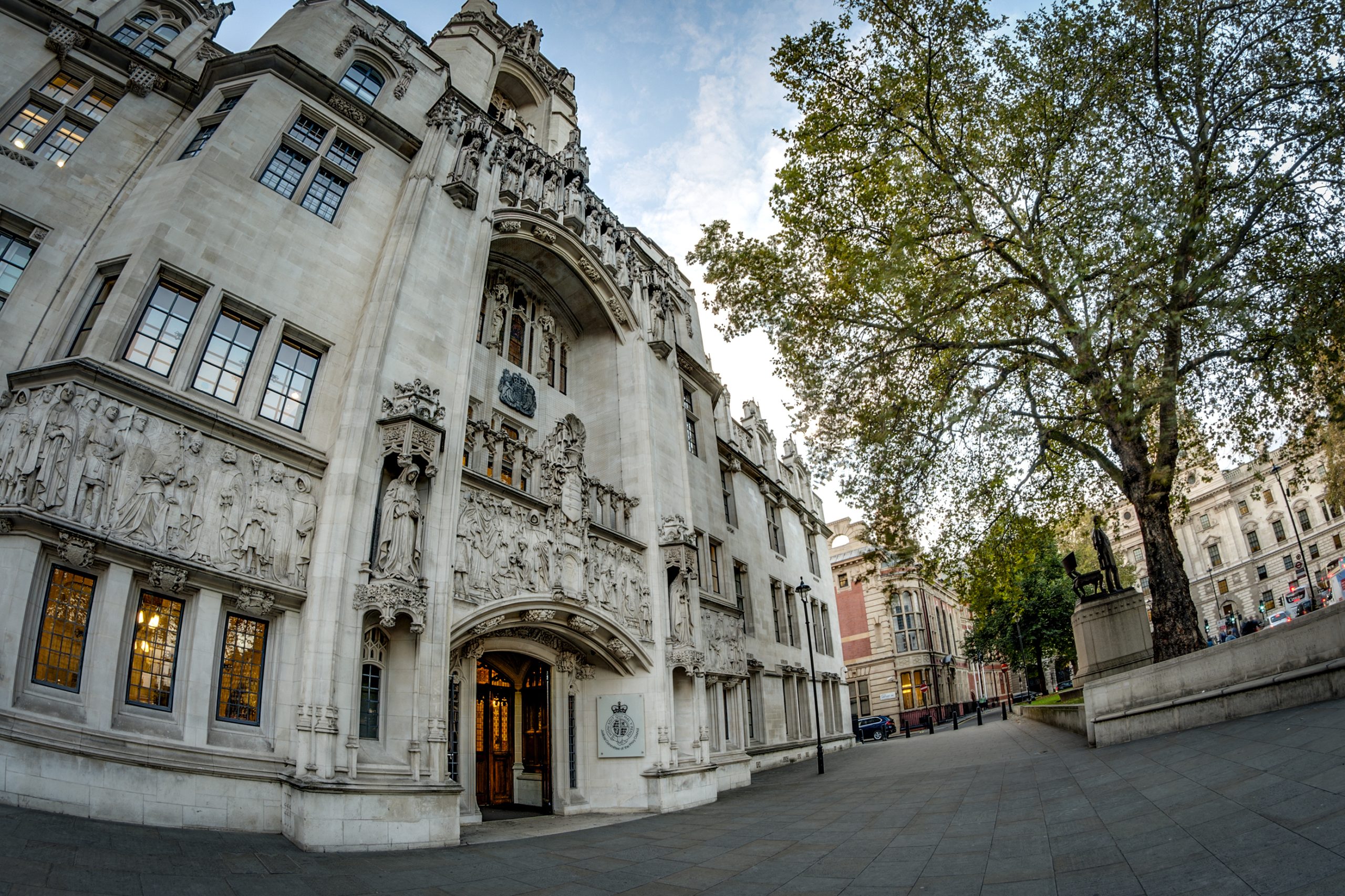
As we have reported previously, the Court of Appeal (CoA) dramatically overturned the High Court’s decision on the patentability of a music recommendation system invented by Emotional Perception AI (EPAI). The CoA found that a trained artificial neural network (ANN) involves a computer program. It further found that the ANN of EPAI’s system did not provide a technical contribution, and so amounts to a computer program as such. Because of this, the CoA held that EPAI’s system was not patentable.
Today, the UK Supreme Court (UKSC) heard EPAI’s appeal from the CoA decision. This hearing has been keenly followed by many within the IP world, as the resulting decision is likely to have a considerable impact on how AI patent applications are handled in the UK, potentially for many years to come. Given that there is no automatic right to appeal to the UKSC, the very fact that the UKSC has granted EPAI permission to appeal the CoA decision indicates the legal significance of this case. Remarkably, the Chartered Institute of Patent Attorneys (CIPA) and the IP Federation (IPF) have even weighed in on the matter by jointly filing an intervention in support of EPAI’s case.
Like with the CoA hearing, the notable aspects of the UKSC hearing centred around how the terms computer and technical contribution should be interpreted. EPAI sought to narrowly interpret the former, while broadly construing the latter. Interestingly, EPAI asserted that the courts should adopt the approaches taken by the European Patent Office (EPO) to resolve these matters. Of course, the UKIPO pushed in the opposing direction, while asserting that the well-established UK jurisprudence is sufficient to answer these questions.
EPAI’s stance
EPAI argued that the Aerotel test that is currently used in the UK is not a suitable test for determining the technical contribution of an invention. They asserted that Aerotel outlines a subtractive process, where any known features of a claimed invention (such as generic computing hardware in this case) are removed from consideration until all that is left is the “clever” part, or the technical contribution (the trained ANN in this case). EPAI argued that this does not accurately reflect the contribution that the invention makes as a whole, as there is no consideration of interactions arising between the clever and known parts of the invention (how the trained ANN interacts with the computing hardware to bring about an improved music recommendation, for example). In EPAI’s opinion, this failure to acknowledge these interactions leads to a narrow interpretation of the technical contribution – one which is more likely to engage the exclusions of Section 1(2) of the Patents Act (for example, the computer program as such exclusion in EPAI’s case). This opinion was echoed in the intervention filed by CIPA and IPF.
EPAI asserted that the courts should adopt the two-hurdle approach currently used by the EPO when assessing technical contribution. This approach involves a two-step test for determining the patentability and inventiveness of a computer-implemented invention (CII).
The patentability test (the first hurdle) requires that the claimed invention include “any technical means” or “any hardware”. EPAI asserted that, unlike Aerotel, the first hurdle is carried out without considering the prior art. This is to ensure that the invention relates to a field of technology, and so is eligible for patent protection. An example of an invention which would not pass this first hurdle may be a set of rules for a new card game. During the hearing, EPAI argued that their claimed invention passes the first hurdle, as it includes generic computing hardware.
The inventiveness test (the second hurdle) involves determining, at first glance, whether each feature of the invention is in itself technical or non-technical (that is, eligible or ineligible for patent protection). It is often the case that CIIs include a mix of technical and non-technical features. Then, the invention is compared with the prior art to find which features of the invention are novel (regardless of whether they are technical or non-technical in themselves).
After this, there is a determination as to which novel features contribute to the technical solution of a technical problem, these features then being taken into account when assessing inventive step. This determination is not as straightforward as admitting the technical features and discounting the non-technical features. Rather, it includes a consideration of whether the novel but non-technical features interact with any technical features (whether novel or not) in order to provide the technical solution to the technical problem. An example of this would be an anti-lock braking system controlled by computer software – the software (which may be considered non-technical in itself at first glance) causes the computer (known technical feature) to control a car’s brakes (known technical features) to prevent the car from crashing in slippery conditions (that is, provide a technical solution to the technical problem of ensuring road safety in adverse weather conditions). As a result, the software would be taken into account when assessing the inventiveness of the anti-lock braking system.
During the hearing, EPAI asserted that their ANN interacts with the generic computing hardware in order to provide a better song recommendation than currently known techniques, and so regardless of whether it is in itself technical or non-technical, it contributes to a technical solution to a technical problem when taking into account EPAI’s invention as a whole.
EPAI further argued that the two-hurdle approach is not only the correct way to assess technical contribution, but is also readily adoptable in the UK, as it is entirely in keeping with the current UK test for inventiveness. Additionally, EPAI contended that the adoption would provide much needed consistency between the EPO and the UKIPO, as it is typically the case that a patent application for a CII is more likely to be refused by the UKIPO as being unpatentable (using Aerotel) but is more likely to be granted by the EPO (using the two-hurdle approach). CIPA and the IPF echoed this sentiment, further asserting that this is currently a point of frustration in the UK IP profession.
Regarding the term “computer”, EPAI asserted that this should be interpreted in line with the conventional understanding of a computer, that is, the digital computers which we all know and use nowadays. In light of this interpretation, a program for a computer should be seen as a sequence of instructions (typically of an “if-then” structure) that a processor of the digital computer carries out to perform a task. EPAI argued that this interpretation aligned with that of the EPO, and that its adoption in the UK courts would provide much needed consistency between the two authorities.
Given this, EPAI asserted that the weights and biases of the ANN are not a computer program, as they are not a set of instructions to be enacted by a processor. Thus, the “computer program as such” exclusion could not apply, as there is no computer program to begin with. Rather, EPAI contended that it is inappropriate to view the ANN’s weights and biases as separable from its structure, as these features are intertwined as a composite whole. In their opinion, it would be like separating capacitance from its capacitor – an absurdity. As such, EPAI asserted there is no clear delineation of “software” from “hardware”, but rather a more complex structure which must be taken as a whole. Thus, EPAI argues that the weights and biases should be considered as part of the ANN’s complex structure, not a sequence of instructions telling the ANN what to do.
The UKIPO’s stance
The UKIPO argued that “a program for a computer” (as recited in Section 1(2)(c) of the Patents Act) should be interpreted broadly in order to take into account the analogue computers and AI machines (such as the Mark I Perceptron) that already existed at the time the Act was drafted, not just digital computers. The UKIPO contended that the “program” may well be a sequence of “if-then” instructions in the case of a digital computer, but should also mean a set of weights and biases in the case of an ANN (which does not utilise “if-then” instructions).
To demonstrate this point, the UKIPO argued that the weights and biases of an ANN can be separated from its structure, contrary to EPAI’s arguments. In particular, UKIPO asserted that once an ANN is trained, its learnt weights and biases may be obtained, copied, and transposed onto untrained copies of the ANN. The UKIPO used the example of self-driving cars. A first stage would be to train an ANN (hosted on a computer in an R&D lab, for example) with image data taken from dashcams. Then during a deployment stage, the trained ANN’s weights and biases are transposed into each car’s untrained ANN to instantly provide the car with a road-safe self-driving ability. In this way, the learnt weights and biases may be thought of as a program for a computer (that is, the car’s untrained ANN in this case).
In light of this, the UKIPO asserted that the weights and biases of EPAI’s ANN (which provide the music recommendation capability) similarly amount to a computer program.
Regarding “technical contribution”, the UKIPO argued that the Aerotel test is still suitable for assessing whether EPAI’s weights and biases provide a technical contribution or are merely “a program for a computer … as such”.
Contrary to EPAI’s arguments, the UKIPO asserted that Aerotel provides a holistic view of the claimed invention – the process of identifying the claimed invention’s technical contribution is not a subtractive process in which known features are removed, but rather takes the invention as a whole into consideration. The UKIPO contended that if any features are removed, it will be those features which do not add to this technical contribution (usually extraneous details). In the UKIPO’s opinion, this holistic consideration puts Aerotel on equal footing with the two-hurdle approach, and so does not need to be thrown out.
The UKIPO asserted that both approaches yield similar answers, this point being acknowledged by the UKSC previously in Actavis v ICOS. However, in the UKIPO’s opinion, the Aerotel test provides a more logical reasoning behind the answer. The UKIPO emphasised this point by using an analogy to a mug with a painted decoration. In Aerotel, the contribution would be seen as the decoration, as the mug is replaceable with any other surface that is paintable. This contribution would then be seen as falling entirely within the “aesthetic creation” exclusion of Section 1(2)(b) of the Patents Act, and thus not patentable. In the two-hurdle approach, the presence of the mug makes the entire invention eligible for patent protection (it passes the first hurdle), but the difference between the prior art (mugs in general) is the painted decoration. This difference would not be seen as an inventive one, and there are no interactions between the painted decoration and the mug which would suggest that a technical problem is being solved. The UKIPO felt that objecting on grounds of aesthetic creation, rather than evaluating the inventive merit of the painted decoration, is more in keeping with the provisions of the Patents Act.
The UKIPO then stated that Aerotel and the two-hurdle approach have peacefully co-existed for almost 20 years, and that if there were any divergence in the answers provided by the two, EPAI (and even CIPA and the IPF) should have been able to find at least one example of this occurring over this long period of time.
The UKIPO then argued that EPAI seek to create a “Frankenstein” approach by mixing the first (“any hardware”) hurdle with the Pozzoli inventive step test. In the UKIPO’s opinion, this would effectively render the exclusions of Section 1(2) as virtually meaningless, as the patentability criteria would be met by merely using any hardware, and the inventive step criteria would be met by demonstrating a non-obvious difference (not necessarily a solution to a technical problem). The UKIPO asserted that this mixing of approaches had been suggested to the High Court in Halliburton, but was dismissed for similar reasons.
Using Aerotel, the UKIPO asserted that the contribution provided by EPAI’s invention was an ANN-based system of recommending music files, and more specifically the set of weights and biases of the ANN – this is seen by the UKIPO as the key feature which provides the song recommendation capability. These weights and biases seek to provide a better song recommendation, which the UKIPO argued does not provide a technical effect, rather a subjective one (the end user’s emotional response to the song recommendation, for example). Coupled with the assertion that the weights and biases should be viewed as a computer program, the UKIPO argue that the contribution of EPAI’s invention falls solely within the “program for a computer … as such” exclusion, and thus is not patentable.
Conclusion
This hearing has been fascinating to watch, not least because of the impact the resulting decision is likely to have on the handling of AI patent applications here in the UK.
We are eagerly awaiting the UKSC’s decision so that we can continue to provide updates and analysis.
Please get in touch with our attorneys at gje@gje.com if you would like to discuss how this might affect your portfolio, or any specific cases.


